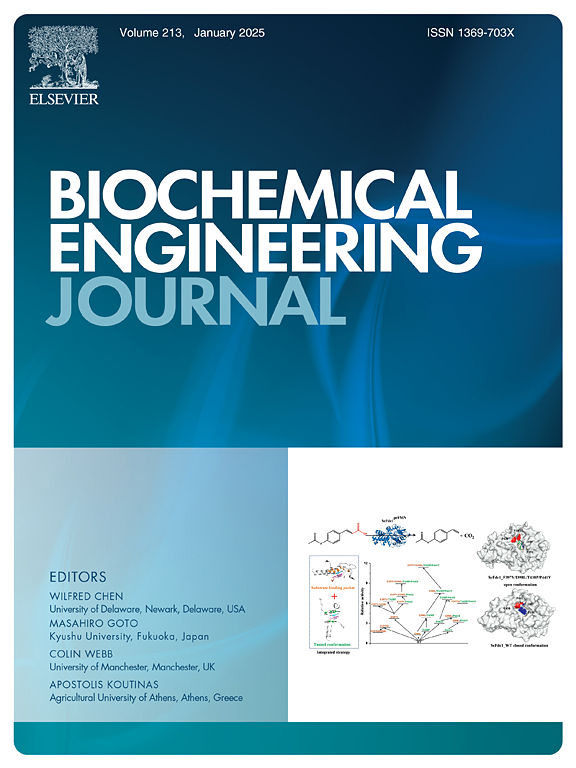液体石蜡气载体在气液混合泵的气泡塔反应器中提高了HOB微生物蛋白的产量
IF 3.7
3区 生物学
Q2 BIOTECHNOLOGY & APPLIED MICROBIOLOGY
引用次数: 0
摘要
利用自养氧化氢细菌(HOB)生产微生物蛋白(MP)被认为是一种有潜力的饲料或食品供应技术。然而,由于O2和H2的溶解度较低,如何匹配生物O2和H2的消耗速率和转移动力学是实现期望的HOB蛋白生产的关键挑战。本文介绍了用自吸气液混合泵在气泡塔反应器中以液体石蜡作为气体载体生产HOB MP。自吸式气液混合泵提高了气液混合效率,液体石蜡提高了O2和H2的溶解度。这种综合效应优化了O₂和H₂的传递动力学,导致O2的KLa从0.69增加到1.81 H−1,H2的KLa从0.37增加到1.67 H−1。因此,添加液体石蜡后,NH4+-N对HOB蛋白的产率从4.21 ± 0.18 gMP∙gN−1提高到5.18 ± 0.68 gMP∙gN−1,干燥生物质的平均蛋白质含量为53 ± 5 %,O2和H2吸收率接近100 %。必需氨基酸谱分析表明,液体石蜡的存在对蛋白质品质没有显著影响。这些结果表明,气载体和反应器的集成设计是可行的,以解决在MP生产中的气体传输限制。本文章由计算机程序翻译,如有差异,请以英文原文为准。
Liquid paraffin gas carrier enhanced the HOB microbial protein production in a bubble column reactor with a gas-liquid mixing pump
Microbial protein (MP) production through autotrophically hydrogen-oxidizing bacterium (HOB) has been regarded as a potential technology for feed or food supply. However, due to the low solubility of O2 and H2, how to match the biotic O2 and H2 consumption rate and the transfer kinetics presents the key challenge to achieve desired HOB protein production. Here, we introduce liquid paraffin as a gas carrier in a bubble column reactor with a self-priming gas-liquid mixing pump for HOB MP production. The self-priming gas-liquid mixing pump facilitates the efficiency of gas-liquid mixing, while the liquid paraffin improves the solubility of O2 and H2. This combined effect optimizes the kinetics of O₂ and H₂ transfer, resulting in an increase in the KLa from 0.69 to 1.81 h−1 for O2, and from 0.37 to 1.67 h−1 for H2. Consequently, the yield of NH4+-N to HOB protein increased from 4.21 ± 0.18 gMP∙gN−1 to 5.18 ± 0.68 gMP∙gN−1, and an average protein content of 53 ± 5 % in dried biomass was achieved with nearly 100 % O2 and H2 uptake after adding liquid paraffin. The essential amino profile analysis shows that the presence of liquid paraffin has no remarkably impact on the protein quality. These results demonstrate that integration of gas carrier and reactor design is viable to address the gas transfer limitation in the MP production.
求助全文
通过发布文献求助,成功后即可免费获取论文全文。
去求助
来源期刊

Biochemical Engineering Journal
工程技术-工程:化工
CiteScore
7.10
自引率
5.10%
发文量
380
审稿时长
34 days
期刊介绍:
The Biochemical Engineering Journal aims to promote progress in the crucial chemical engineering aspects of the development of biological processes associated with everything from raw materials preparation to product recovery relevant to industries as diverse as medical/healthcare, industrial biotechnology, and environmental biotechnology.
The Journal welcomes full length original research papers, short communications, and review papers* in the following research fields:
Biocatalysis (enzyme or microbial) and biotransformations, including immobilized biocatalyst preparation and kinetics
Biosensors and Biodevices including biofabrication and novel fuel cell development
Bioseparations including scale-up and protein refolding/renaturation
Environmental Bioengineering including bioconversion, bioremediation, and microbial fuel cells
Bioreactor Systems including characterization, optimization and scale-up
Bioresources and Biorefinery Engineering including biomass conversion, biofuels, bioenergy, and optimization
Industrial Biotechnology including specialty chemicals, platform chemicals and neutraceuticals
Biomaterials and Tissue Engineering including bioartificial organs, cell encapsulation, and controlled release
Cell Culture Engineering (plant, animal or insect cells) including viral vectors, monoclonal antibodies, recombinant proteins, vaccines, and secondary metabolites
Cell Therapies and Stem Cells including pluripotent, mesenchymal and hematopoietic stem cells; immunotherapies; tissue-specific differentiation; and cryopreservation
Metabolic Engineering, Systems and Synthetic Biology including OMICS, bioinformatics, in silico biology, and metabolic flux analysis
Protein Engineering including enzyme engineering and directed evolution.
 求助内容:
求助内容: 应助结果提醒方式:
应助结果提醒方式:


